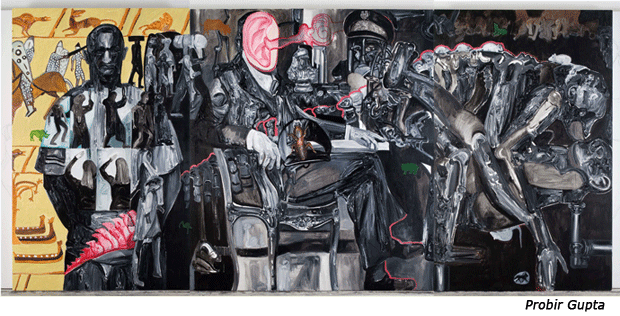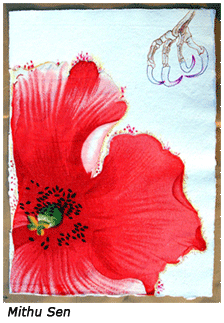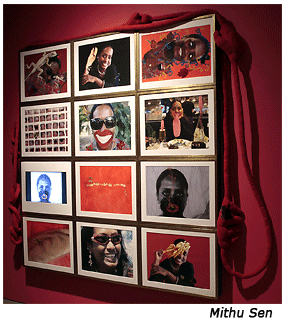- Prelude
- Guest Editor’s Column
- Hard Talk
- Digital Art
- The Write Stuff
- The Art of the Shakers : Shaker Furniture
- New Media
- In the News
- GenNext
- Report
- Artist Index and Statistics
- Market Insight
- Auction Reports
- The month that was
- Mumbai Artsighting
- Musings from Chennai
- Delhi Dias
- Deccan Odyssey
- Art Bengaluru
- In between – from Vadodara
- North-East Opsis
- A Tryst with Art in Madhya Pradesh
- Strands of Social Semiotics
- Transcending Popular
- Art of the Land & Land in Art (part I)
- Through The Patina
- Earth
- Go See India
- Dali's Elephant
- Malleable Memory
- Creative Impulse
- Different hues of Aakriti
- Bonhams : Fine Writing Instruments New York
ART news & views
Delhi Dias
Volume: 2 Issue No: 7 Month: 8 Year: 2010
Rahul Bhattacharya in conversation with Probir Gupta and Mithu Sen on art, art making and contemporaneity. These are two separate conversations unfolding in the same space, overlapping in time, have been woven together to construct a imaginary conversation.

PG: I don't understand the category of Indian-ness in art.
RB: Though till 2-3 years ago I used to use this question of Indian-ness in contemporary Indian art and strategy to remind artists about a certain responsibility to the local, I now feel that its misunderstood and over used.
PG: Yes, as an artist, I have never thought about this question of Indian-ness. When I work, it is more about what I want to do. My dialogue happens with both, the society and art history. Say for example, my paintings are so impassioned not because  I want them to look Indian or western, but because I am intrinsically a sculptor.
I want them to look Indian or western, but because I am intrinsically a sculptor.
RB: What I'm basically looking for now is how an artist is sensitive to social, political and aesthetic questions of their own surroundings. Let me frame it this way; we produce so many catalogs and circulate it among people who are known not to read them but how many of us send catalogs to art colleges, community reading rooms, etc. there is just no concern…nobody is even thinking in that direction.
MS: Yes, you are absolutely right! The very nature of events like Nandan Mela has changed. It is no longer for people but is now an event for the gallerist.
The conversation takes off from there and goes across various examples. Mithu, Probir and Rahul talk their way through expressing despair about the current state of affair and come to an understanding that maybe mainstream contemporary art till right now is not really interested in having a dialogue with contemporary India. From there the conversation moved to Mithu's last solo in Berlin and she talks about a cultural event in Berlin, where for a weekend a year, galleries stay open till late and museums don't have entry fee. Most of the galleries put up their best shows during this time.
 As Rahul gets up to make coffee, Mithu tells Probir how hundreds and hundreds of people are out on the streets, visiting art galleries, seeing shows, discussing works etc. Probir tells Mithu that in Paris, each zone in the city has an annual festival on the same lines, so the city has about 10 to 12 such art weekends.
As Rahul gets up to make coffee, Mithu tells Probir how hundreds and hundreds of people are out on the streets, visiting art galleries, seeing shows, discussing works etc. Probir tells Mithu that in Paris, each zone in the city has an annual festival on the same lines, so the city has about 10 to 12 such art weekends.
RB: Why is that something like that doesn't happen here? It's not that art was so disconnected from the society all the time; From the 20's till the 70's, we've had art being debated and discussed in mainstream publications. There have been public battles over styles, but somehow the connection is lost.
MS: the art world has changed over the years. Nowadays an artist cannot just behave casually, dress casually, there is an element of glamour that has crept in and is now become a criterion of how an artist presents him/herself.
PG: The best thing is that we can still resist it. There are still a lot of us who do not play upto this expected role and have shown a deep commitment to connect their work with the culture of their contemporary society.
 The conversation opens up as they talk about Probir's work with the Jewish community of Kolkata, his experience of doing art projects with school children and Mithu talks about her 'Free Mithu' project.
The conversation opens up as they talk about Probir's work with the Jewish community of Kolkata, his experience of doing art projects with school children and Mithu talks about her 'Free Mithu' project.
The second cup of coffee gets made as they discuss the kind of public responses that have been received and what are the various urges that make them want to reach out. It becomes interesting when both Mithu and Probir cite certain kinds of education and exposure in the early youth, when the art teachers they met, the idealism embedded in them. Rahul comes back with coffee and brings forward the 'Can it be done in any corner you like?' curation and suddenly they realize that in spite of migrating in Delhi over different decades, this hand-me-down idealism has somehow linked them and influenced their pursuits as artists and writers. After Probir winds up to leave early, the conversation moves on to this notion of local and vernacular and how a majority gets left out of the discourses around contemporary Indian art, just because the discussions unfold in English.
MS: …And sometimes the works come from very very personal zones, and this zone is influenced by the land around you, by the art that you see the people you live with. Sometimes deep personal expressions become universal and are mistaken to be global. It's only when you analyze them and maybe sometimes even psychoanalyze them that you realize where the roots lie.
With that deep challenge thrown to the art historian the conversation begins its journey of winding up…winding down…another cup of coffee gets made.